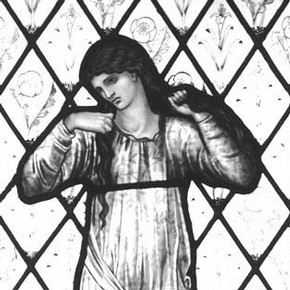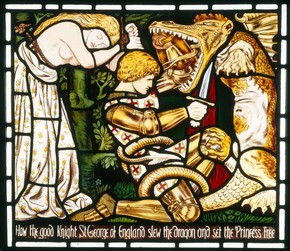Conservation Journal
April 1996 Issue 19
Conservation Liaison - Stained Glass for the William Morris Exhibition
The William Morris exhibition has provided a unique opportunity to display a large number of stained glass panels from the V&A's collection. Despite the scale of the V&A's collection of stained and painted glass, it is not often requested for display in either V&A exhibitions or for loans elsewhere. A total of 19 pieces have been chosen, making it the largest number of panels that the Stained Glass Conservation Section has dealt with for a temporary exhibition. In addition to the V&A glass there are seven panels from other sources also being displayed.
Conservation were asked at a very early stage to inspect the glass coming from outside and to prepare reports. This is not common practice for this type of exhibition, but proved invaluable (usually reports are written only as the borrowed objects arrive at the museum for Government Indemnity). It enabled us not only to assess the objects' conservation needs and make recommendations, but also to identify any unusual display requirements. A number of panels were still in situ and therefore would require specialist removal before any necessary conservation work could be carried out. We were able to assess these and at the same time were able to co-ordinate the display requirements of both our own glass and the incoming glass.
Although stained glass does not require stringent environmental conditions, it is perceived as a difficult material to display. It cannot simply be positioned on a shelf or hung directly on a wall. Wherever stained glass is displayed, Conservation are always involved to some degree in the design specification for the display. The glass usually has to be reframed and requires a specially made box in which to house and diffuse the artificial lighting. There are some general misconceptions about the display of stained glass in an artificial environment. One such misconception is that stained glass always requires high levels of artificial light, which would obviously cause problems for any light-sensitive objects - such as textiles or watercolours - which might be displayed alongside. This is not the case, in that high light levels are not required to display stained glass effectively. In fact stained glass displayed by artificial light is usually lit too brightly and by reducing the light levels it can be viewed in a much more realistic way, closer to displaying it with natural light. This also allays any misgivings about the effect on other light sensitive objects. In the past, Conservation has not been able to influence the levels of light in a display box as stained glass is not affected by light levels, except where the glass has been repaired with resin or other synthetic materials.

'Elaine', panel, Edward Coley Burne-Jones, 1870. Museum no. C.321-1927. (click image for larger version)
A framing system for all the stained glass in the Museum has been developed by the Stained Glass Conservation Section. The need to devise such a system became obvious when we identified problems with the wooden frames that have been used traditionally in the Museum. Acids from the wood attack the lead, particularly around the edges where the leads are held underneath the wooden rebates. Painted aluminium section frames are now being used to replace these old wooden ones. In addition, a sheet of clear Perspex™(ICI) is mounted behind the glass and provides extra support. It is a specification for loan that glass must be mounted in such a way. It also provides, in the case of this exhibition, the designer with a consistent system from which to design the display. It is also possible with this type of frame to have additional Perspex mounted in front of the glass. This is particularly important if the glass is going to be displayed in a low position where it might be touched.
Interventive conservation work on the V&A glass has not been extensive. Only one panel has required major conservation work and releading. Other glass required only superficial cleaning and some minor repairs. Cleaning glass of this period is quite difficult as the paint surface is often quite fragile and so any solvent cleaning is kept to a minimum.
All the V&A glass was chosen from the primary displays of stained glass. In order to provide minimal disruption in the galleries, the glass was removed for a short period of time before Christmas. Templates were then taken from each panel for the new frames. The glass was replaced back into the old wooden frames and returned to the galleries. It was removed again closer to the exhibition date to allow further work to be carried out.
The majority of the conservation work required on the incoming glass was carried out by a firm of private conservators, although some minor work was carried out by the Museum's conservators. The work done in the stained glass studio was mainly to provide additional support to the glass or to facilitate the positioning of the new metal frames. When all the glass was in the studio, the designers were able to complete their own measurements and identify for us which panels would be displayed low enough to need protection on the front of the panels. It was important to establish this requirement at that stage because, depending on the thickness of the glass and depth of lead, it is sometimes necessary to have the frame made with additional depth to allow for the extra sheet of Perspex. It was also at this stage that a decision was made not to reframe the largest piece from outside the Museum, Noah's Ark and Christ and Apostles. It was mounted in a large wooden box, glass-plated at the front and back. As it would be returned in that frame, it was agreed that the work and the risk involved in temporarily removing it and then replacing it would not be viable. It was also agreed that the King Rene's Honeymoon series from the V&A collection would also remain in its wooden frame, as these panels form part of a room scheme in the Victorian Primary Galleries and it would not be appropriate to introduce major alterations.
The involvement of Conservation from the early stages, especially in the assessment of the incoming objects has been of great value. It has allowed us to plan our input more accurately and assess resource implications, thus enabling more precise costings for the Conservation Department.
April 1996 Issue 19
- Editorial
- Preparing for Morris - the Treatment of a Philip Webb Painted, Silvered Chest
- Conservation Course Abstracts: Update
- Conservation Liaison - Stained Glass for the William Morris Exhibition
- Digital Imaging and Stained Glass Conservation
- The Restoration of the East Staircase Ceiling and the Leighton Corridor, Victoria & Albert Museum
- The 'Leighton Project': Backstage
- Printer Friendly Version
